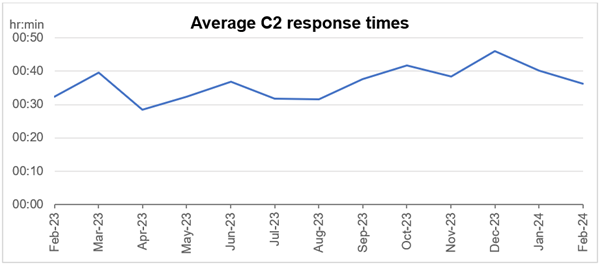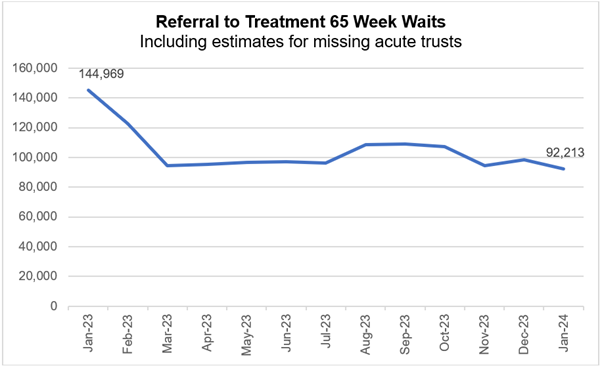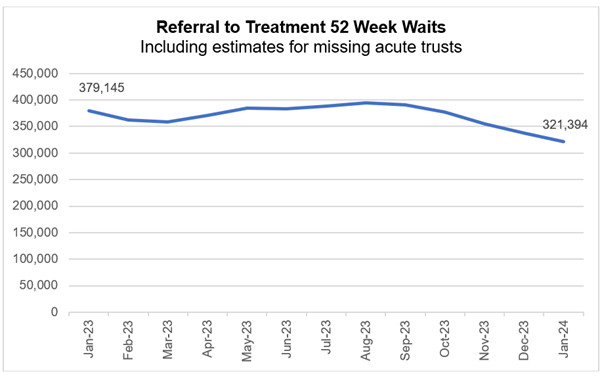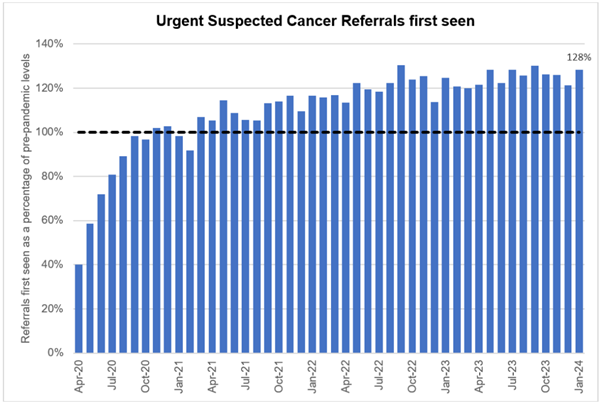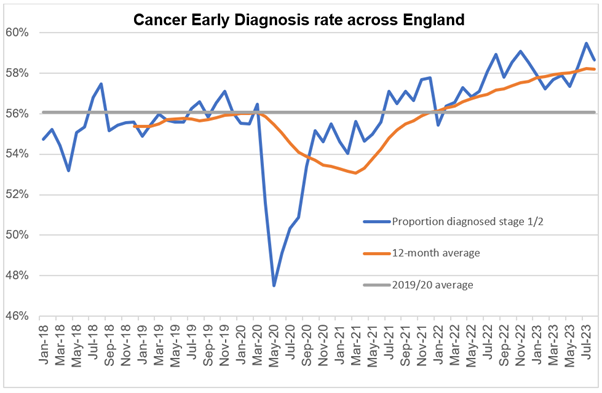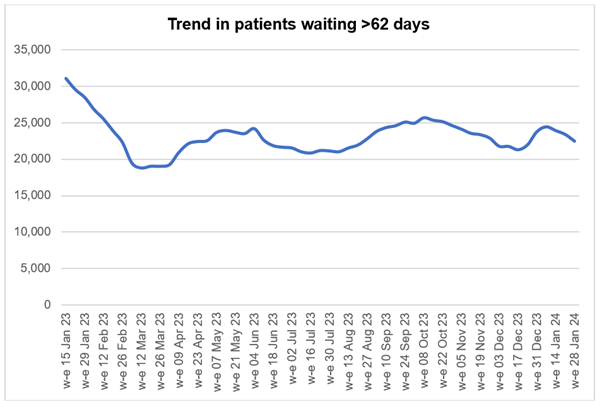Organisation objective
- Statutory item
Executive summary
Demand for NHS services across the country remains high. NHS staff managed to sustain increased bed capacity levels to meet demand in February, despite ongoing winter viruses, 5 days of industrial action and high bed occupancy putting pressure on urgent and emergency care services. 103,408 general and acute beds were available in February, up from 101,092 in February last year. An average of 99,917 core beds were available, up from 99,529 in January.
There were 2,152,361 attendances in A&Es across England, an average of 74,219 per day. This is 8.6% higher than February 2023 and 3.4% higher than January 2024’s daily average.
Ambulance services answered 763,141 calls to 999, or 26,315 per day. This is an increase of 12% when compared to the same month last year.
The average ambulance response time for a category 2 call was 36 minutes and 20 seconds. This is 3 minutes and 46 seconds faster compared to January.
The total waiting list reduced for a fourth consecutive month. As of the end of January, 92,213 (1.2%) patients were waiting more than 65 weeks for treatment. This is down by 36.4% compared to January 2023, and down from 98,374 (6.3%) in December.
Demand for cancer services continued at record levels in January with the number of urgent suspected cancer referrals at 128% of pre-pandemic levels. To meet high demand, treatment is also at record levels and there has been a reduction in the 62- day cancer backlog as a result. The increase in referrals has contributed to the NHS diagnosing more cancer at an early stage than ever before.
Over 338,000 people received treatment for cancer over the last year between February 2023 and January 2024 – the highest year on record, and up by more than 25,000 on the same period pre-pandemic.
More people than ever before are now in contact with NHS services for support for their mental health, with almost 5 million patients in contact with services in 2022/23, an increase of more than 1 million compared to 2016/17.
Urgent and emergency care
- Ongoing winter viruses, high bed occupancy and 5 days of industrial action all placed pressure on urgent and emergency care (UEC) services in February. Despite these challenges, staff have managed to sustain increased bed capacity levels to help cope with demand.
- There were 103,408 general and acute beds available in February, up from 101,092 in February last year. An average of 99,917 core beds were available, up from 99,529 in January, meaning the NHS continues to ensure that additional capacity is in place to meet the pressures experienced during winter months.
- There were 2,152,361 attendances in A&Es across England, an average of 74,219 per day. This is 3.4% higher than January’s daily average and 8.6% higher than February 2023.
- 9% of patients attending A&E were admitted, transferred or discharged within 4 hours. This compares to 70.3% in January.
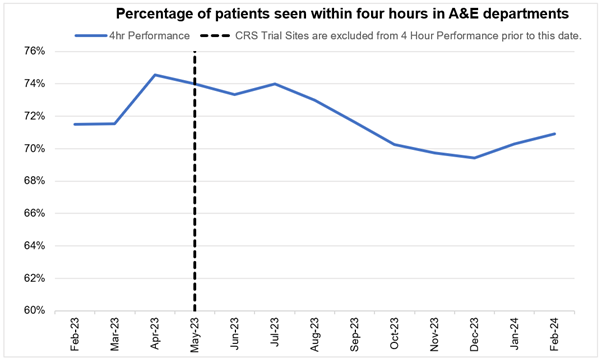
Graph showing percentage of patients seen within 4 hours in A&E departments.
5. Ambulance services answered 763,141 calls to 999, or 26,315 per day. This is an increase of 12% when compared to the same month last year. They dispatched ambulances to 604,321 incidents.
6. The average ambulance response time for a category 2 call was 36 minutes and 20 seconds. This is 3 minutes and 46 seconds faster compared to January.
Graph showing average category 2 response times
Elective Recovery
7. Thanks to the efforts of staff, the NHS continued to make progress in reducing long waits for patients in January. This is despite dealing with widespread disruption from 6 days of industrial action and winter demand.
8. As of the end of January, 92,213 (1.2%) patients were waiting more than 65 weeks for treatment. This is down from 98,374 (6.3%) in December and down by 36.4% compared to January 2023 (144,969 patients were waiting more than 65 weeks for treatment in January 2023).
Graph showing referral to treatment 65 week waits
9. 321,394 (4.2%) patients were waiting more than 52 weeks for treatment. This is down from 337,450 (4.8%) in December and down by 15.2% compared to the same month last year (379,145 patients were waiting more than 52 weeks for treatment in January 2023).
Graph showing referral to treatment 52 week waits
10. The total waiting list reduced for a fourth consecutive month. As of the end of January, there were 7.58 million waits for procedures and appointments and an estimated 6.32 million people waiting for care.
11. 1,570,551 patients started treatment in January, an increase of 3.3% compared to January 2020, and 1,001,784 started treatment within 18 weeks of referral. For the last 7 months more patients have started treatment per working day than before the pandemic.
12. Additional capacity has been created through community diagnostic centres. Over 7 million tests, checks and scans have been delivered for patients so far, as part of efforts to bring down waiting lists.
Cancer
13. Demand for cancer services continued at record levels in January with the number of urgent suspected cancer referrals at 128% of pre-pandemic levels. To meet high demand, treatment is also at record levels and there has been a reduction in the 62- day cancer backlog as a result.
Graph showing urgent suspected cancer referrals first seen
14. Over 338,000 people received treatment for cancer over the last year between February 2023 and January 2024 – the highest year on record, and up by more than 25,000 on the same period pre-pandemic.
15. GPs have been referring people for urgent cancer checks in record numbers since March 2021. Since then, NHS staff have seen over a million more people than in the same period prior to the pandemic. The increase in referrals has contributed to the NHS diagnosing more cancer at an early stage than ever before. We are diagnosing a higher proportion of cancers at an early stage now than ever before – about 2% higher than before the pandemic.
Graph showing cancer early diagnosis rate across England
16. The NHS is working hard to keep up with this increase in demand. It has been accelerating the installation of new diagnostic capacity, much of it in community diagnostic centres.
17. The backlog has already reduced by over 10,000 people since its peak last summer, and despite the recent seasonal increase, NHS staff remain focused on ensuring that people who have been waiting longest or who need care most urgently are seen first.
Graph showing trend in patients waiting >62 days
Mental health
18. More people than ever before are now in contact with NHS services for support for their mental health, with almost 5 million patients in contact with services in 2022/23, an increase of more than 1 million compared to 2016/17. This includes 1.1 million children and young people, 1.3 million adults in contact with core community mental health services, 1.2 million adults in contact with NHS talking therapies services, and 85,000 people in contact with specialist perinatal mental health services.
19. As service access has expanded, so too has data completeness and quality, which is an important but often overlooked part of service transformation. Over the last 3 years the number of organisations submitting data to the Mental Health Services Dataset has increased from 298 in January 2021 to 364 submitters in January 2024. These newly submitting providers, often smaller voluntary care and social enterprise (VCSE) partners, are key to providing patients with integrated community models of mental health provision, and their contribution to the national dataset is a critical step in recognising and demonstrating the value they provide to patients.
20. The overall quality and completeness of data submitted to the Mental Health Services Dataset has also been improving. The Data Quality Maturity Index gives an overall percentage score for the quality and completeness of data in national health datasets. The scores for data quality for NHS trusts submitting mental health data is now at 89% in November 2023, up from 83% in November 2022. The NHS Talking Therapies Dataset has also remained among the highest scoring NHS datasets at 98% in November 2023. This is a significant step in achieving parity of esteem for data in mental health services, with NHS mental health trusts achieving scores close to or above other NHS datasets for physical health. NHS England will continue working with NHS trusts and other smaller organisations, such as the independent sector and VCSE providers, to achieve further improvement across the whole mental health sector.
21. NHS England has supported mental health providers to increase the speed of data submission and reporting process, that has enabled mental health data to be reported a month earlier since December 2023. This means data is now available 2 months after month end rather than 3 months as before. Alongside improved data quality, this change enables information and insight on NHS mental health care in England to be available more quickly and reliably for everyone involved in providing and improving services.


